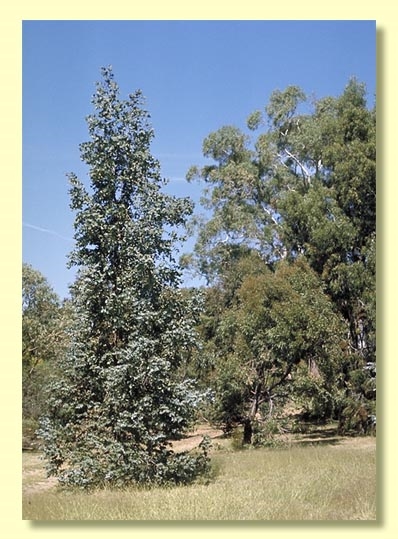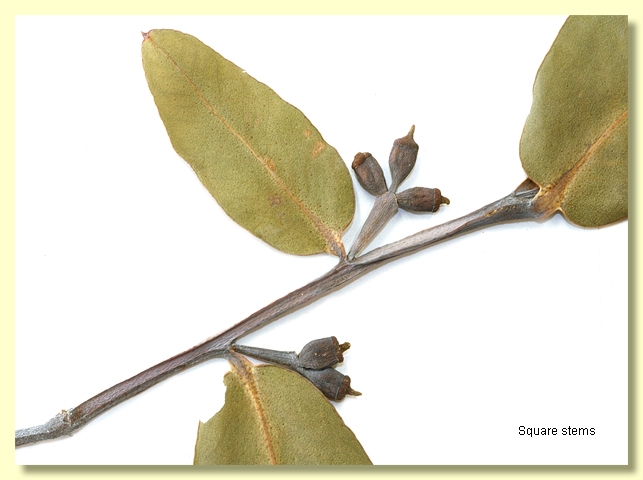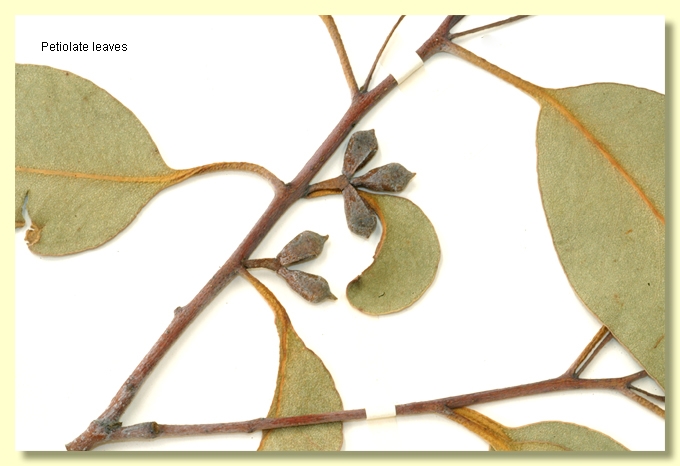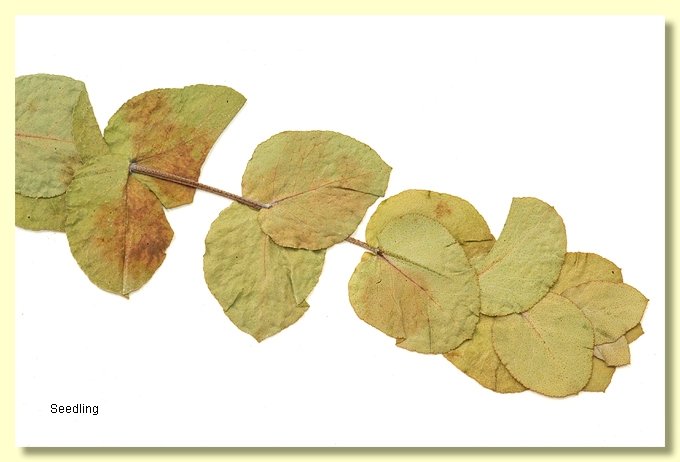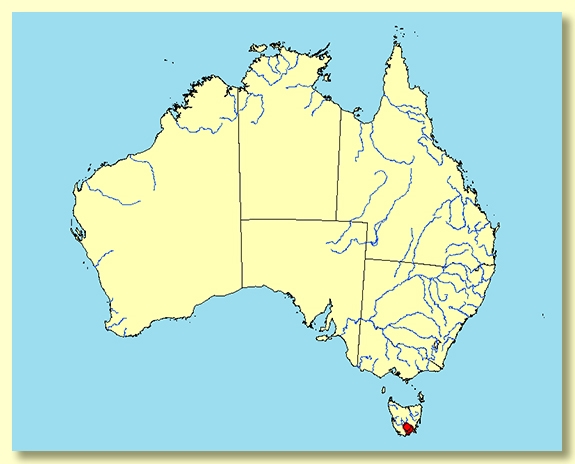Euclid - Online edition
Eucalyptus cordata subsp. quadrangulosa
Eucalyptus | Symphyomyrtus | Maidenaria | Euryotae | Orbiculares
Eucalyptus cordata subsp. quadrangulosa D.Nicolle, B.M.Potts & McKinnon, Papers and Procs Royal Society of Tasmania 142(2): 75-77 (2008).
T: Tasmania: Snug Plains, 15 April 1979, A.M.Gray 357 (holo: HO; iso: CANB).
Tree to 11m (uncommonly 25 m) tall with branching and foliage extending well down the trunk, or bushy shrub 2+ m tall. Forming a lignotuber.
Bark smooth, mottled, greenish, white, brown, blue-grey and grey; on tallest trees there may be some basal slabs of rough grey-brown bark low on trunk; branchlets glaucous, squared in cross-section.
Juvenile growth (coppice or field seedlings to 50 cm): stem squared in cross-section, or even slightly winged, glaucous, very warty; juvenile leaves opposite and sessile for many pairs, orbicular to cordate, 3–8.5 cm long, 2.7–8 cm wide, base amplexicaul, apex usually rounded and mucronate, margin sub-crenulate, glaucous weathering to grey-green or green.
Crown of juvenile leaves only on smaller plants, but in tree forms intermediate and adult leaves occur also. The progression in leaf form goes like this: juvenile leaves are opposite, sessile, orbicular to cordate with base stem-clasping and apex rounded and mucronate, and tend to be paler on the underside, have a scalloped (subcrenulate) margin and are more heavily glaucous; intermediate leaves are still opposite but are petiolate, blades elliptical to oblong and still a bit paler on the underside; adult leaves are alternately placed on the branchlet, petiolate, blades lanceolate, and are concolorous, often glaucous or weathering to grey-green. The leaf margin tends to be entire in intermediate and adult leaves; side-veins greater than 45° to midrib, venation moderately to densely reticulate, intramarginal vein well removed from margin, oil glands island and intersectional. Considering all stages in leaf development the following dimensions apply: petiole 0–2(3) cm long, blade 3–8.5(17) cm long, 2.5–8(9.5) cm wide.
Inflorescence axillary unbranched, peduncles (0.2)0.3–1.2 cm long, buds 3 per umbel, sessile or with a 0.3 cm pedicel on central bud. Mature buds obovoid to pyriform, 0.9–1.3 cm long, 0.7–1.0 cm wide, glaucous, maybe weakly angled or not, scar present (outer operculum shed early), inner operculum ca 0.4-0.6 cm long, rounded to flattened and usually apiculate, stamens inflexed, anthers cuboid to oblong, versatile, dorsifixed, dehiscing by longitudinal slits (non-confluent), style long, stigma blunt or tapered, locules 3 or 4, the placentae each with 6 vertical ovule rows. Flowers white.
Fruit sessile or rarely with a 0.2 cm pedicel (on central fruit), cup-shaped, shortly barrel-shaped to truncate-globose, 0.8–1.3 cm long, 1–1.5 cm wide, weakly angled longitudinally or not so, usually glaucous at least when newly formed, disc descending vertically or obliquely, valves 3 or 4, near rim level or just enclosed.
Seeds dark brown, greyish or black, 1.5–3 mm long, ovoid or flattened-ovoid, dorsal surface smooth, hilum ventral.
Cultivated seedlings (measured at ca node 10): cotyledons bilobed; stems squared in cross-section, glaucous, warty; leaves opposite and sessile for many nodes, orbicular to cordate, 3–4.5 cm long, 1.5–3 cm wide, base amplexicaul, apex rounded and mucronate, margin sub-crenulate, usually glaucous.
Flowering has been recorded from September to December (after Williams & Potts, 1996, p. 62).
A shrub or small to medium-sized tree restricted to south-eastern Tasmania from Moogara to Port Arthur and Mt Wellington, and Maria Island, at intermediate altitudes on well developed loams on moist sites and in coastal heath.
Eucalyptus cordata differs from the other three-budded species by the persistence of large, opposite, orbicular to cordate, glaucous juvenile leaves through much or all of the mature crown. These leaves have subcrenulate (scalloped) margins. Buds and fruit are large, smooth, glaucous when young and may be sessile or very shortly pedicellate. Populations vary in width of leaves and whether the branchlets are square or rounded in cross-section.
E. cordata has two forms, the eastern typical form and the western form (see Potts 1989) which were formalized as subspecies in 2008:
E. cordata subsp. cordata
Has branchlets rounded in cross-section both in reproductive plants and coppice growth, and is always a large shrub, never a tree. It is found in coastal and subcoastal south-eastern Tasmania, from Mount Grosse south of Hobart north to Bluestone Tier near Triabunna and east to Bruny Island and Maria Island, occurring in moist situations in woodland and heath at altitudes from near sea level to ca 450 m asl on silty clay soils that are often shallow.
E. cordata subsp. quadrangulosa
Branchlets squared in cross-section both in reproductive plants and coppice growth, and can form much larger shrubs and trees to 25 m tall. Restricted to the subcoastal ranges of south-eastern Tasmania, especially Snug Plains, Moogera and the Wellington Range. Habitat: moist loamy to clayey soils at altitudes 400 to 700 m asl, on margin of swamps or seepages on level to gently sloping sites near taller forests.
In the classification of Brooker (2000) Eucalyptus cordata belongs in Eucalyptus subgenus Symphyomyrtus section Maidenaria, a large group of species restricted to south-eastern Australia, characterised by bilobed cotyledons, simple axillary inflorescences, buds with two opercula the outer of which sheds during bud growth leaving a scar, stamens with versatile anthers and flattened seeds with a ventral hilum. Within this section, E. cordata, with nine other species, forms series Orbiculares having orbicular juvenile leaves opposite for many nodes, usually glaucous crown, and buds in threes. Series Orbiculares is confined to far south-eastern New South Wales, eastern Victoria and Tasmania.
Eucalyptus cordata: Latin cordatus, heart-shaped, referring to the leaves.
subsp. quadrangulosa : from Latin quadrangulosus meaning four-cornered referring to the squared branchlets.

